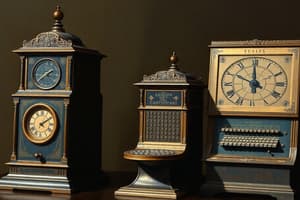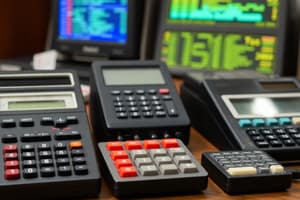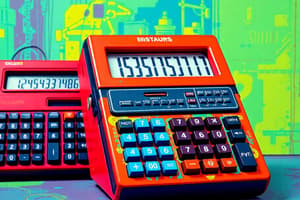Podcast
Questions and Answers
The Arithmometer was invented by Thomas de Colmar in 1820.
The Arithmometer was invented by Thomas de Colmar in 1820.
True (A)
Charles Babbage invented the first electronic computer in 1834.
Charles Babbage invented the first electronic computer in 1834.
False (B)
Augusta Ada Byron wrote programs for the Analytical Engine in 1840.
Augusta Ada Byron wrote programs for the Analytical Engine in 1840.
True (A)
The Scheutzian Calculation Engine was the first electronic calculator.
The Scheutzian Calculation Engine was the first electronic calculator.
Herman Hollerith invented the first tabulating machine in 1890.
Herman Hollerith invented the first tabulating machine in 1890.
The Harvard Mark 1, also known as IBM Automatic Sequence Controlled Calculator, was invented in 1945.
The Harvard Mark 1, also known as IBM Automatic Sequence Controlled Calculator, was invented in 1945.
The Difference Engine was designed to tabulate polynomial functions.
The Difference Engine was designed to tabulate polynomial functions.
The first mass-produced calculating machine was the Difference Engine.
The first mass-produced calculating machine was the Difference Engine.
The Osborne 1 was released in 1980 and is known as the first portable computer.
The Osborne 1 was released in 1980 and is known as the first portable computer.
The first computer company was founded by John Presper Eckert and John Mauchly.
The first computer company was founded by John Presper Eckert and John Mauchly.
The electromechanical age occurred between 1840 and 1940.
The electromechanical age occurred between 1840 and 1940.
The premechanical age is defined as the time between 3000 A.D. and 1450 A.D.
The premechanical age is defined as the time between 3000 A.D. and 1450 A.D.
The electronic age represents the period from 1940 to the present.
The electronic age represents the period from 1940 to the present.
The first high-speed digital computer was known as the ENIAC.
The first high-speed digital computer was known as the ENIAC.
The Greeks were the first to devise a numbering system that includes the concept of zero.
The Greeks were the first to devise a numbering system that includes the concept of zero.
The mechanical age of information technology began in 1800.
The mechanical age of information technology began in 1800.
The time period for the mechanical age overlaps with that of the electromechanical age.
The time period for the mechanical age overlaps with that of the electromechanical age.
Cuniform was the first form of writing used by the Sumerians around 3000 B.C.
Cuniform was the first form of writing used by the Sumerians around 3000 B.C.
The Egyptians created the first books by folding sheets of papyrus into leaves.
The Egyptians created the first books by folding sheets of papyrus into leaves.
The number 100 was represented by a coiled rope in the Egyptian numbering system.
The number 100 was represented by a coiled rope in the Egyptian numbering system.
The first calculators were developed during the Pre-Mechanical Age and included devices like the Abacus.
The first calculators were developed during the Pre-Mechanical Age and included devices like the Abacus.
The Roman alphabet was directly adopted from the Greek alphabet without any modifications.
The Roman alphabet was directly adopted from the Greek alphabet without any modifications.
Permanent storage devices during ancient times primarily consisted of scrolls made by the Egyptians.
Permanent storage devices during ancient times primarily consisted of scrolls made by the Egyptians.
The first numbering systems similar to those in use today were developed in Mesopotamia around 100 A.D.
The first numbering systems similar to those in use today were developed in Mesopotamia around 100 A.D.
Computer technology combined with GPS does not allow users to pinpoint their exact location.
Computer technology combined with GPS does not allow users to pinpoint their exact location.
Working from home has become increasingly uncommon, limiting access to necessary data.
Working from home has become increasingly uncommon, limiting access to necessary data.
Social media platforms allow people to exchange photographs and memes in real time.
Social media platforms allow people to exchange photographs and memes in real time.
Drones are used solely for filming purposes in the military.
Drones are used solely for filming purposes in the military.
Remote working allows managers to monitor workers' productivity while they are away from the office.
Remote working allows managers to monitor workers' productivity while they are away from the office.
GPS technology is effective at tracking incoming missiles in military applications.
GPS technology is effective at tracking incoming missiles in military applications.
Customization of settings such as air-conditioning temperatures is not possible with modern technology.
Customization of settings such as air-conditioning temperatures is not possible with modern technology.
Dating sites and apps have no role in helping people find romantic relationships.
Dating sites and apps have no role in helping people find romantic relationships.
The punch card was invented in 1890 and is made of stiff paper containing digital information represented by holes.
The punch card was invented in 1890 and is made of stiff paper containing digital information represented by holes.
The Z1, built by Konrad Zuse in 1941, was the first electronic computer.
The Z1, built by Konrad Zuse in 1941, was the first electronic computer.
The Mark I was a programmable computer that was also the first stored program computer.
The Mark I was a programmable computer that was also the first stored program computer.
The first generation of computers was in use from 1959 to 1964.
The first generation of computers was in use from 1959 to 1964.
The first generation computers used vacuum tubes and were often large, taking up entire rooms.
The first generation computers used vacuum tubes and were often large, taking up entire rooms.
The ABC Computer laid the foundation for advances in analog digital computers.
The ABC Computer laid the foundation for advances in analog digital computers.
The fifth generation of computers extends from today into the future.
The fifth generation of computers extends from today into the future.
The Z3, built by John von Neumann, was the first programmable computer.
The Z3, built by John von Neumann, was the first programmable computer.
Flashcards are hidden until you start studying
Study Notes
Historical Developments in Computing
- Arithmometer: Invented by Thomas de Colmar in 1820, it was the first reliable mechanical calculator capable of performing the four basic arithmetic functions and was also mass-produced.
- Difference Engine & Analytical Engine: Created by Charles Babbage in 1822 and 1834, respectively; marked as the first mechanical computer designed to compute polynomial functions.
- First Computer Programmer: Augusta Ada Byron wrote programs for Babbage’s Analytical Engine in 1840 and suggested using the binary system.
- Scheutzian Calculation Engine: Established by Per Georg Scheutz in 1843; recognized as the first printing calculator based on Babbage’s concepts.
- Tabulating Machine: Created by Herman Hollerith in 1890 to enhance information summarization and accounting, utilizing punch cards.
- Harvard Mark 1: Developed by Howard H. Aiken in 1943, it was the first electro-mechanical computer with a memory for data and stored programs.
- First Portable Computer: The Osborne 1, launched by Osborne Computer Corporation in 1981, is regarded as the first portable computer.
- First Computer Company: Founded in 1949 by John Presper Eckert and John Mauchly, it was initially named Electronic Controls Company, later changed to Eckert-Mauchly Computer Corporation (EMCC).
Stages of Information Technology Development
- Pre-mechanical Age (3000 B.C. - 1450 A.D.): Characterized by the development of writing systems, notably cuneiform in Mesopotamia and alphabets adapted by Greeks and Romans.
- Mechanical Age (1450 - 1840): Emergence of devices such as the mechanical calculators; this age connects ancient tools to modern-day technology.
- Electromechanical Age (1840 - 1940): Introduction of early telecommunications technologies, including punch cards for storing data.
- Electronic Age (1940 - Present): Defined by the development of high-speed digital computers; includes innovations such as the ENIAC, the first reprogrammable computer.
Milestones in Computing
- Z3: First programmable computer built by Konrad Zuse in 1941.
- Mark I: Constructed by John von Neumann in 1942 as the first stored-program computer, known for its massive size and complexity.
- ABC Computer: The Atanasoff-Berry Computer, created by John Atanasoff and Clifford Berry in 1942, was the first all-electronic computer and laid the foundation for future advancements.
Generations of Computers
- First Generation (1946-1958): Utilized vacuum tubes and magnetic drums; characterized by large physical size.
- Second Generation (1959-1964): Transitioned to transistors, improving efficiency and reliability.
- Third Generation (1965-1970): Emerged integrated circuits, further decreasing size and increasing speed.
- Fourth Generation (1971-Present): Marked by microprocessors and personal computers.
- Fifth Generation (Present-Future): Focused on artificial intelligence and advanced computing technologies.
Applications of Information and Communication Technology (ICT)
- Navigation: Integration of computers with GPS technology allows precise location tracking and mapping of nearby amenities.
- Working from Home: The rise of remote work facilitates access to data and communication without an office environment; managers can monitor productivity online.
- Military Applications: Utilized for training, intelligence data analysis, and smart technology control; enhances geospatial information capabilities and targeting.
- Social Interactions: Social media platforms enable real-time communication and content sharing, while dating apps assist in finding romantic partners.
Studying That Suits You
Use AI to generate personalized quizzes and flashcards to suit your learning preferences.




